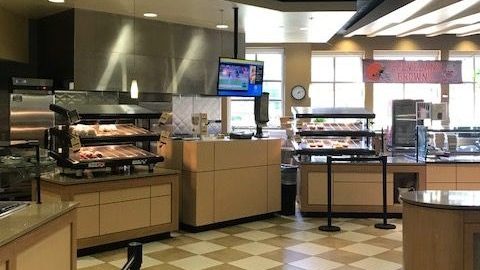By Michael Chopra ‘20
Picture this: you come to visit Saint Ignatius High School on a school day as a parent of a prospective student. You are awestruck by the beautiful scenery of the campus, impressed by the wonderful facilities that the school has to offer, and captivated by the amazing faculty and staff that make the school work. Then, in your delightful astonishment, you make your way to the cafeteria in the Rade Dining Hall to see what hearty and exquisite nourishment awaits the hungry student in this Disneyland-esque utopia. You walk into the café, past a sign that designates what a healthy school meal consists of: select amounts of fruits, grains, vegetables and a protein. “Maybe my son will finally eat healthy for once” you say. You are excited to finally get to see the food, so you stride over to the entrée station where you see… macaroni and cheese topped with chicken nuggets… for five dollars.
In general, Americans do not eat a very healthy diet. The very fact that a meal is considered as a hamburger with French fries washed down by a Coke proves that. That’s not a meal; that’s an indulgence. It’s also not very healthy or nutritious, by the way. Also, where are the fruits or vegetables in that?
According to the U.S. Office of Disease Prevention and Health Promotion, three-fourths of the population has an eating pattern that is low in vegetables and fruits, and most Americans exceed the recommendations for added sugars and saturated fats. “No! That’s not me!” you say. Perhaps. But eating patterns like that definitely occur in the cafeteria. On a daily basis, it is quite difficult to meet all four categories of fruits, vegetables, grains, and a protein when eating a meal from the cafeteria. That is unless you buy the main line meal, and then a salad, and then a piece of fruit, and then a pint of milk if you want some dairy. All of this will add up to a price of, we’ll say, $10 for a possibly healthy lunch, and this on a daily basis, for a student. Rack up those Wildcards, gentlemen.
To be frank, I don’t think that it should be that expensive for a healthy school lunch, and I also don’t think that one should have to go to four different places just to satisfy all of the recommended meal food groups (I also don’t think that we should have a station designated as the “fry station” on a daily basis). I think that the cafeteria should have at least one, singular meal every day that can be qualified as healthy.
We are a Jesuit school, and we adhere to the Jesuit philosophy of cura personalis, or “care for the whole person.” Fostering health and wellness for students with the food served in the cafeteria is undoubtedly an aspect of that philosophy. There are many Jesuit schools that apply cura personalis to their lunch programs. Take Creighton Prep, a Jesuit high school in Nebraska, for example. According to their website, they provide “a full lunch menu on a daily basis, complete with a wide variety of fresh, healthy foods and different portion sizes.” And their students can return for seconds if they’d like! Students at Creighton Prep do not have to pay daily for their meals, as the annual fee for their lunches is included in tuition. They are great meals by the way, and some examples of entrees include “steakhouse marinated pork tenderloin” and even a “chipotle black bean burger,” and all meals are served with some form of fruits and vegetables. Now that’s a school
lunch I can get behind.
You might think that I sound particular or strict about the fact that our food isn’t very healthy. But think about it: a student who is taking six to seven classes and involved with sports or extracurricular activities should absolutely be getting quality nutrition from the school they attend, especially here at Ignatius, considering how rigorous classes and outside activities can be.
That being said, I do believe that there are some good food options in the cafeteria such as the great salad bar, the soups, and occasionally the action station. And those cookies in the morning are the best chocolate chip cookies I’ve ever had! All in all, what I’m offering here is a suggestion for the cafeteria to explore options of offering more nutritious and higher-quality options for both the students and the faculty/staff here who purchase food from the cafeteria. Saint Ignatius is an unbelievably great and unique institution across the board, but when there is a problem or a deficiency with one of its components, it needs to be addressed and acted upon to ensure that all aspects of the school reflect its mission and style.






